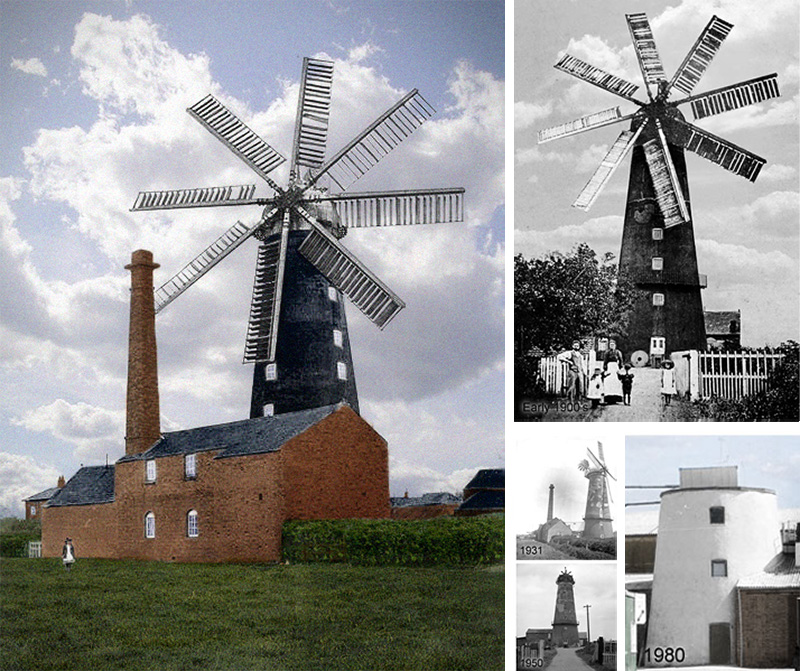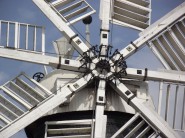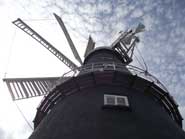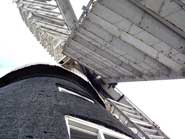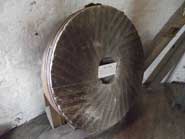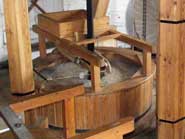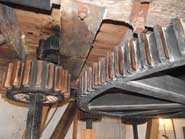The earliest windmill in the village is recorded as being built in the 13th century by the Abbot William of Woodford (1295-9) at Eyebury, this would most certainly have been a post mill. Eye Green Smock Mill was to the north east, close to where Northern Close is today, Eye Tower Mill was the tallest and opposite the cemetery. Just to the north was The Hirne and The Three Horseshoes Windmills.
Early windmills were post mills where the whole mill could be pivoted into the wind on a vertical post. Smock mills came later and were mostly made of wood with a sloping tower that had six or eight sides. Tower mills appeared in the 15th century and consist of a fixed brick tower on which a cap revolved to face the wind.
Eye Smock Mill
By the end of the 19th-century wind and water, power had largely been superseded by more efficient means. Eye Green’s 200-year-old smock mill was one of the only mills of its type in Northamptonshire to survive into the twentieth century, by the mid 20th century even that had gone. Built of wood, smock mills were not as strong as their counterparts built of brick and quickly fell into disrepair after they were abandoned.
Lacey Green Windmill is a restored smock Mill in Buckinghamshire and is open to the public during the summer months. It is a very similar design to the Eye Smock mill. Click here for further information.
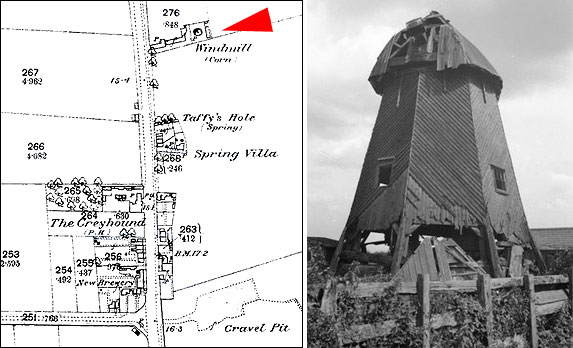
By the second world war only two mills were still grinding in Peterborough, Eye tower mill and a smaller mill at Werrington.
Eye Tower Mill
Eye Tower Mill was the last windmill standing in Eye. A limited edition, only seven eight sailed windmills were ever built in England. Built around 1821 the height of the tower was increased sometime in the 1850s. The mill was around 70ft (21m) (nearly as high as the church tower is now), 100ft if you include the length of the sails, had seven floors and the cap was of an ogee design. Each sail measured 33ft (10m) in length.
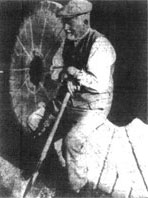
The cap was fitted out in the typical Lincolnshire style for the time. The wrought iron shaft leading from the cap to the spur wheel was said to be seven inches (189mm) in diameter, the largest in the area. The main overdriven machinery and four pairs of stones for grinding the corn were on the second floor while the third and fifth floors were occupied by grain bins. At some time an eight horsepower Gimson steam engine from Leicester was added to the adjacent boiler house which drove the various dressing machines and crushers.
Windmills are known to suffer damage in severe weather and Eye Mill was no different. During one storm in 1895 fifty shutters were ripped out the sails. In the mid 20th century a storm ripped off one of the sails which ended up in a nearby field. Accidents were also known to happen. Mr Oldham who once owned the mill is reported to have said that once a sail fell off and nearly killed a man, on another occasion in the 1920s three of the sails came off and crashed into the granary adjoining the mill reducing it to ruin. Sails were expensive even in those days, £200 a sail was not uncommon even in the early 20th century. A lot of this expense was because the main beam of the sail would be made from one piece of solid oak. Modern replacement sails use a laminate as oak cannot be bought in the lengths required. Nowadays a single sail can cost upwards of £10,000 to build and fit.
In 1898 the mill was up for auction at the Angel Hotel in Peterborough – a full itinerary of the site was listed: “An old – established substantial tower windmill, (seven floors). in excellent working order in the important village of Eye, situated near to Eye Green Station and to the junction of Thorney and Crowland roads, fitted with eight patent sails, four pairs of stones (three pairs French and on pair Grey), Victor smut machine, double cylinder flour dressing machine, single cylinder ditto, two middlings purifiers, one three-roller plant; bean mill, etc; the whole being well fitted for the purpose of carrying on a Wholesale Flour Trade and an extensive Grist business. Together with a large warehouse and boiler house, containing 8 h.p. engine by Gimson, of Leicester, with shafting connections to the mill, boiler with Galloway tubes, stabling for two horses, fodder house, cart shed with loft and spacious yard”. The mill must have sold because the Keeble brothers owned the site from 1898 – 1906.

Winding down
The sails were removed in 1948 after an inspection had discovered that the mill was in a dangerous condition due to the severe rot in the gallery supports. By 1950 the mill was described as derelict and by the late 1960s the cap and machinery had been removed for safety. Although a lot of money had been spent on maintenance by 1971 the brick had rotted to such an extent that the tower had to be reduced to three storeys. This remained until 1982 when even this was demolished and so ended another era in the village’s history. The mill continued working until the early 90s. After closure the buildings were demolished, and for a number of years the area remained derelict. Around 2010 the land was sold and hoses were built on it. The only remaining piece is a gate post next to the old school which was the main entrance to the mill.
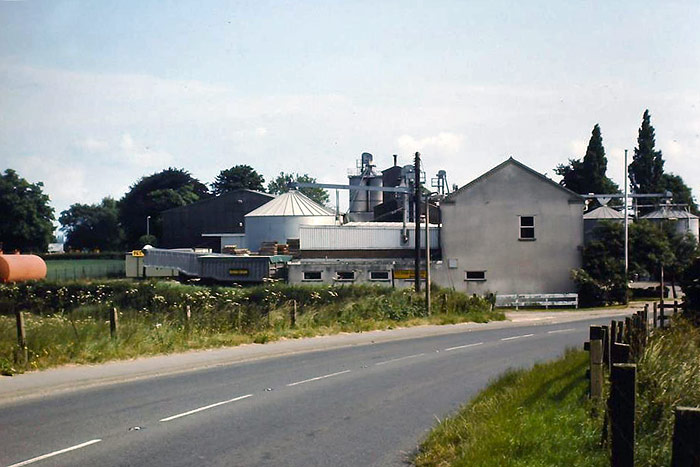
Known owners
New – 1861 – William Palmer
1861 – 1898 Joseph Collins
1898 – 1906 Keeble brothers
1906 – 1938 William Oldham
1938 – 1942 James Oldham
1942 – 1952 Rex Wailes
1952 – 1980’s Joseph Odam
Although all of Eye Mills have perished Thorney’s nearby Mill was saved and converted to a home.
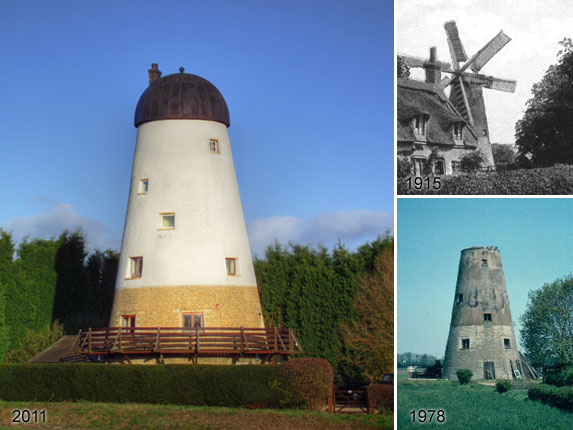
Heckington Windmill
The only surviving eight-sailed windmill in the country. The mill ceased work in 1946 and deteriorated until it was purchased by Kesteven County Council in 1953 and made safe. It was first opened to the public in 1983, underwent restoration in 1986 and further major repairs were carried out in 2004. The mill is now in full working order. Only an hour’s drive from Eye, it’s a few miles north of Springfields in Spalding, well worth a visit. A few photos I took from a recent visit are below. It’s about as close as you will get to how Eye’s tower mill would have been.
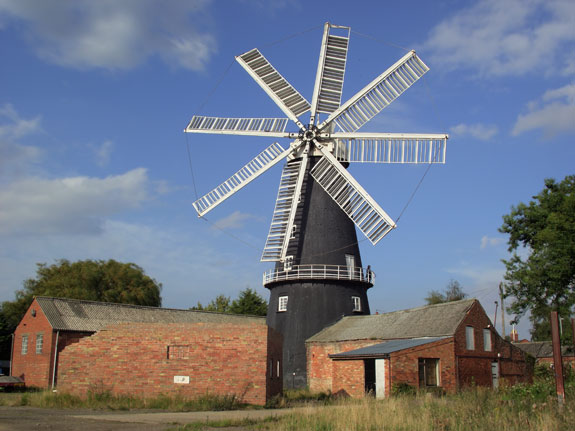
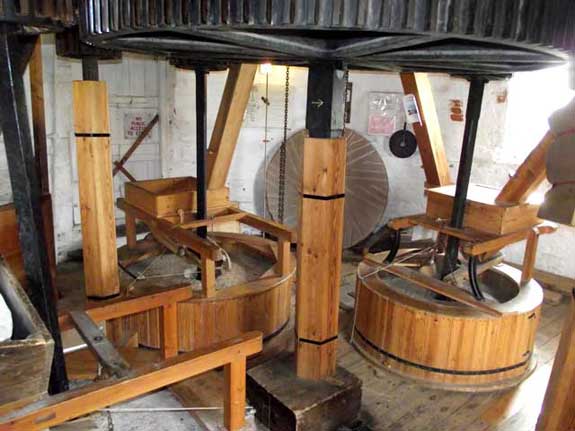
Reference
Heckington Windmill – A guide and history 2009
Windmills of Northamptonshire and the Soke of Peterborough 1991
The Mill Collection at Kent University
Resources
Windmill Terms

